I was lucky enough to spend most of yesterday on my favourite beach and the first photo below is a record of what I found.
Top row, top left - unknown but seems to be brass and was attached to a lump of badly corroded aluminium - it might not be ammo related. Top row, next one in is the base of a 25 Pr Smoke Base Ejection shell, fitted with a brass band (no trumptets). Top row third item appears to be part of a blown fuze, the underside (last photo) has a monogram that might help place or date its manufacture. Then there is a .303 Inch Ball bullet. Then remains of some No 117 fuzes (one with its striker still attached), then a 20 mm cartridge case (photo of base included), same detail as identified by Spotter on my last relics and wrecks post. Last on the top row is the top time ring from a No 221 Mk 1 time combustion fuze (photos included below). The locating lug / pin is still in place. The majority of No 117 remains I find are Mk 3.
The next two rows are all remains of No 119 fuzes. Most of those I find are Mk 3 or Mk 4, though I have previously found Mk 1 and Mk 7.
The bottom row shows a pile of small pieces of brass, mostly from No 119 fuzes - the internal structure was pulverised by the force of detonation. Also in the bottom row are pieces of driving band, some from 5.5 Inch shell, most from 25 Pr shell and a couple of pieces that are either another calibre or part of 5.5 Inch shell. The near-complete 25 Pr driving bands are from shell that appeared to have deflagrated (low order detonation as some might call it). Those were most certainly HE shell fitted with plugs that were authorised for sea-ward firings and were most likely fitted with plug No 1 or plug No 2.
I took a cheap metal detector with me and estimate that for each thing I found by eye I found twice as much using the detector.
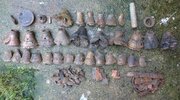
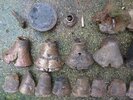
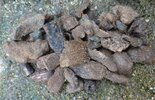
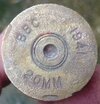
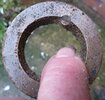
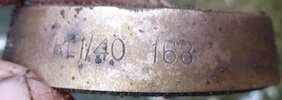

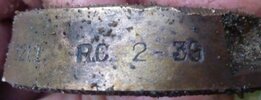
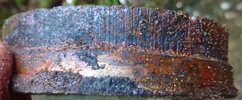
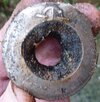
Top row, top left - unknown but seems to be brass and was attached to a lump of badly corroded aluminium - it might not be ammo related. Top row, next one in is the base of a 25 Pr Smoke Base Ejection shell, fitted with a brass band (no trumptets). Top row third item appears to be part of a blown fuze, the underside (last photo) has a monogram that might help place or date its manufacture. Then there is a .303 Inch Ball bullet. Then remains of some No 117 fuzes (one with its striker still attached), then a 20 mm cartridge case (photo of base included), same detail as identified by Spotter on my last relics and wrecks post. Last on the top row is the top time ring from a No 221 Mk 1 time combustion fuze (photos included below). The locating lug / pin is still in place. The majority of No 117 remains I find are Mk 3.
The next two rows are all remains of No 119 fuzes. Most of those I find are Mk 3 or Mk 4, though I have previously found Mk 1 and Mk 7.
The bottom row shows a pile of small pieces of brass, mostly from No 119 fuzes - the internal structure was pulverised by the force of detonation. Also in the bottom row are pieces of driving band, some from 5.5 Inch shell, most from 25 Pr shell and a couple of pieces that are either another calibre or part of 5.5 Inch shell. The near-complete 25 Pr driving bands are from shell that appeared to have deflagrated (low order detonation as some might call it). Those were most certainly HE shell fitted with plugs that were authorised for sea-ward firings and were most likely fitted with plug No 1 or plug No 2.
I took a cheap metal detector with me and estimate that for each thing I found by eye I found twice as much using the detector.










